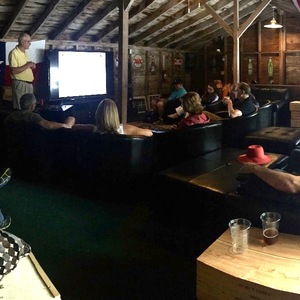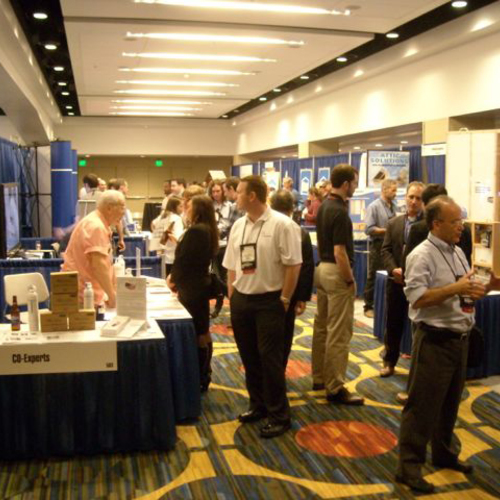The Best and the Brightest Meet Every Year to Talk Green Building
What did I do for summer vacation? I went to camp, met with our advisory team, learned about physics, ate food from Alaska, Dallas, Miami, and Maine. And there were Cubans with cigars, too.
Building science summer camp is an information and consumption festival hosted by Building Science Corporation during the first week of August each year. Officially called the Westford Symposium on Building Science, the by-invitation-only summer camp attracts the best and the brightest in the commercial and residential building fields. There is also very good food, beer, wine, and cigars.
Classes are held during the day at the Westford (Mass.) Regency Hotel and Conference Center. Networking and feasting opportunities occur at the clubhouse each night. The classes are taught by whoever Joe Lstiburek, Ph.D., one of the founders of Building Science Corporation, wants to invite. Typically these teachers are among the best in their fields. This year was no different.
Each day opens with a rundown of the menu by the chef, Pete Consigli.
Summer camp participants do their best to out-do each other each year with their native cuisines. The Alaskans bring halibut and salmon, the Texans bring a steer and slow-roast the brisket, and then there’s the North Carolina barbeque, the Maine clams and mussels, etc. Consigli’s opening comments this year: “The food at summer camp can be summed up three ways: best quality, huge variety, and a hell of a lot of it.”
Even smart people get confused.
Lstiburek likes to say that he’s not a consultant, he’s an insultant. Anton TenWolde, Ph.D., added another layer to the title game: confusant.
After recently retiring from the USDA Forest Products Lab, physicist TenWolde discovered that the stuff he thought he knew he may not know so well. His eyes lit up when someone raised a hand during his presentation and said, “I’m confused.”
There’s a lot to learn from the stuff TenWolde doesn’t know. Here’s what I learned:
- A lot of water in houses comes from people, but it isn’t all from respiration (breathing). A lot can come from transpiration (sweating) too—up to 3 lb. of water per day per person. Coupled with respiration, a family of five dumps up to 33 gal. of water into a house every day.
- Foundations add a lot of water to a house, too: 0.4 kG per sq. m. per day (about a gal. per 44 sq. ft.) evaporate from bare soil in a crawl space.
- It takes six weeks for a sliver of wood to come to moisture equilibrium with its surroundings. And then Lew Harriman asked if we could all underline that in our notes: SIX WEEKS for a teeny piece of wood to come to equilibrium with its environment through ‘sorption. So the oak flooring probably ought to be in the room for more than a couple of days before installation.
Houses can be a huge part of the solution to our energy problem.
Ren Anderson works at the National Renewable Energy Lab and is interested in Net Zero Energy Houses. It’s pretty well known that we can use a lot less power in houses. On Day 1 at camp he talked a lot about the challenge of syncing up local power generation with grid demands. Many houses can generate a lot of power with photovoltaics (PV), but can they provide electricity to the grid when the grid needs it most—during the hot part of the day when everyone flips on the AC?
I learned that:
- Today’s houses are much bigger than houses from the ’50s.
- Today’s houses use much more energy.
- While today’s big houses use less energy per square foot, it’s total energy use that’s important because we don’t make power by the square foot, but by the kilowatt.
- Small houses are more efficient at space heating than large houses; small houses use a smaller percentage of total energy for space heating.
- Large houses get better RESNET scores than small houses because RESNET is based on performance per square foot. For this reason, RESNET (and Energy Star) is biased toward larger houses (but the Energy Star bias may be changing).
- It is very cost effective to slash home energy use by 50%. The second 50%, to get to zero energy, is less cost effective at current energy prices. If energy prices go up (which they may), higher efficiencies will be very cost effective too.
- PV panels on houses can provide peak power to the grid if the panels are turned to face west rather than south, because their generation curve will be shifted an hour or two later in the day—just when the grid needs electricity.
- Eighty percent of the houses in America are built by 20% of the builders. Production builders risk going the way of GM if they don’t lead the world in energy efficiency.
At the clubhouse, I learned that more and more regional green-building programs, such as Earth Craft House from Atlanta and Earth Advantage from Oregon, are expanding. Earth Craft is in six southeastern states and Earth Advantage is moving toward New England. This may mean that the big national programs need to get their acts together and start making sense.
—Dan Morrison is managing editor of GreenBuildingAdvisor.com.
Weekly Newsletter
Get building science and energy efficiency advice, plus special offers, in your inbox.















6 Comments
Building Science Summer Camp
Dan,
It sounds like "summer camp" was an enlightening experience that everyone should be lucky enough to get invited to.
While looking at your Day 1 summary, one item really jumped out at me - Eighty percent of the houses in America are built by 20% of the builders. Production builders risk going the way of GM if they don’t lead the world in energy efficiency.
Having worked as a subcontractor for production builders for the better part of the last 20 years, there is one constant I have learned: Maximizing shareholder value will never get anyone a quality home.
I am curious (rhetorically) as to how production builders could ever muster the courage to act in a manner that is not designed to cut corners in order to maximize profits. The one component you did not mention is that participants in production homebuilding seldom actually know, or care to know, anything about construction, much less building science.
Production builders are in the business of moving money and homes are just the vehicle they use to move money. The ongoing downturn in housing has seemingly prodded these so-called builders to further cut corners and lessen quality even more. I am constantly amazed at their lack of leadership.
So, I'll leave you with one question: Do you think the production homebuilder industry can change their whole business philosophy and become leaders of quality rather than quantity?
The Future of Production Building?
Yes. It seems to me that whenever someone offers to finance the product they sell, they're in the banking business, not the [home building, auto, windows, furniture...] business. At least not primarily.
Will production home builders be able to lead they way?
The answer is like anything else: it's not black and white. Some production builders are already doing smart things, some never will. Vernon McKown (Ideal Homes) in Oklahoma is offering energy guarantees on his new houses. Other builders are building leaky boxes that rot off their foundations five years after they're built.
Thinning of the herd is always a good thing in the long run. Maybe a little painful in the short term, though.
Thanks for your comments,
Dan
Production Builders
Dan,
Thanks for pointing out Ideal Homes - looks like they put their money where their mouth is. I do agree that thinning the herd will be best for the long term viability of the homebuilding industry.
BTW, I see in your bio that you built in Tennessee. What part were you in? I live in Franklin.
Grant
Nashville
I framed houses in Franklin and Brentwood, remodeled and built cabinets in Nashville. Lived in Lakewood and Old Hickoty, right on the lake.
Invitation-only
How do you get invited to go to BS Summer Camp? Also, I'm just curious, but what's the men-to-women ratio at this camp?
It took me a $500 bottle of wine
But that's another story. The male/female ratio, while I've never actually counted, seems about even.
Log in or create an account to post a comment.
Sign up Log in